A fundamental question that many curious people have who casually venture into the discipline of Physics is: What is science?
We answer:
Science: rational explanations
It is important to emphasize that this definition makes no provision for traditional activities that most people associate with science such as observing, measuring, collecting data, running experiments, measuring, calculating, predicting, inventing or developing technology, etc. These are investigative tasks that a researcher performs prior to a conference.
Similarly, presenting evidence, proving, persuading, convincing, converting, recruiting, establishing contacts, forming clubs, and rewarding individuals for their discoveries are activities of an extra-scientific, missionary nature. These proselytizing processes are typically set in motion after a conference.
The definition of Science prescribed here is circumscribed to what happens at the conference proper: explaining mechanisms objectively for the sole purpose of understanding.
Science is restricted to what happens at the conference. A physicist is required to explain a mechanism objectively. The ideal way to do this is for the theorist to make a movie of the mechanism so that the audience can understand it by merely watching the film. All other activities, including presenting evidence, proving, and running experiments, have the sole purpose of influencing the jurors and are treated as extra-scientific
